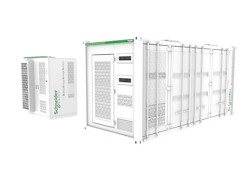Think Microgrids Are Too Complicated? Schneider Takes on the Problem with a New Battery as its Latest Step
When you hear about delays with microgrid installations, the word “battery” frequently comes up.
Batteries don’t always play nicely with other devices and can create engineering challenges.
Schneider Electric, one of the larger players in the microgrid market, has decided to take on this problem with a new battery energy storage system (BESS), which it previewed to partners and the media on Wednesday at the Microgrid Knowledge conference in Baltimore, Maryland.
The battery is the second step by the energy management and digital automation company to make microgrids easier for those who lack utility-level engineering skills. The first step, previewed at last year’s Microgrid Knowledge conference, was the release of “Microgrid Flex,” a standardized microgrid system designed to be rapidly deployed and easily configured.
The battery and Micro-Flex together “just make it a lot simpler for people to get started, do it fast, beat some of the supply chain issues that are out there and perpetuate the delivery and installation of more microgrid systems,” said Don Wingate, a vice president of sales for Schneider Electric.
Battery use growing
Schneider’s new play comes at a time when energy storage is expected to become an increasingly important part of a microgrid.
“With the expected growth in demand for battery energy storage, this launch is a big deal,” said Jana Gerber, Schneider Electric’s president of North America microgrids. “The timing is perfect for us to introduce our new BESS.”
If new projects are built at the expected rate, batteries are poised to become the dominant energy resource within a microgrid by 2026, according to Elham Akhavan, senior microgrid research analyst at Wood Mackenzie.
“If nothing extraordinary happens to delay projects, battery energy storage could very soon eclipse diesel as a resource used in microgrids — and even eclipse solar,” said Akhavan, who spoke at the Think Microgrid workshop during the first day of the conference.
What might cause extraordinary delays?
Because of the novelty of the technology, community microgrids that use batteries can be snagged by permit delays and slowdowns during the testing and commissioning phase, according to Akhavan.
She said delays may also occur because skilled workers are becoming increasingly scarce as the Inflation Reduction Act accelerates the development of new energy projects.
Diving deeper into the battery
Schneider enters a crowded battery market with its new offer. Mark Feasel, FuelCell Energy’s executive vice president and chief commercial officer, said two features jumped out at him that set the battery apart: fire safety protection features and the ability to play well with other devices.
Vendors often must integrate safety mechanisms for a battery, so having them already implemented simplifies the process, he said. While a utility may know how to do this, “that’s not true of H.E.B grocery stores or Home Depot,” said Feasel, who attended Wednesday’s briefing.
“The second thing that really stood out is its implementation of a virtual synchronous generator. It can be very difficult when you design a microgrid to control that battery in such a way that it plays well with other devices. You spend a lot of time in the field tuning the battery. This is a big problem that the industry has wrestled with for a long time,” Feasel said.
A virtual synchronous generator allows the battery to operate like a natural gas or diesel generator. “Once you can make that battery operate like something that's already well understood, it's much easier to integrate with anything,” Feasel said. “So the whole story is that it has the capability to massively reduce on-site installation and commissioning time for a microgrid.”
Steve Pullins, chief technology officer for AlphaStruxure, a joint venture of the Carlyle Group and Schneider Electric, pointed to four features of the battery that stood out for him. The BESS can serve multiple use cases, offers a “closed” or “seamless” transition from grid-connected to island mode and back, maximizes safety and is “purpose built” for microgrids, he said.
About the Author
Elisa Wood
Editor-in-Chief
Elisa Wood is the editor and founder of EnergyChangemakers.com. She is co-founder and former editor of Microgrid Knowledge.
